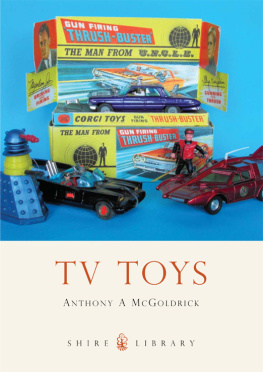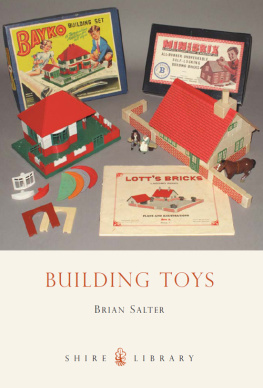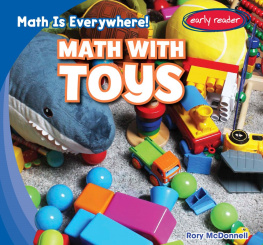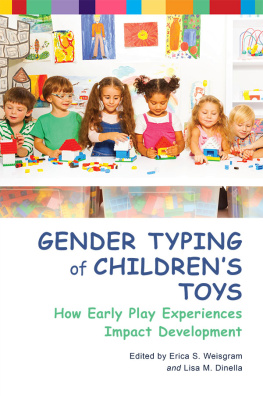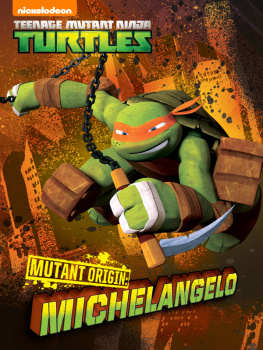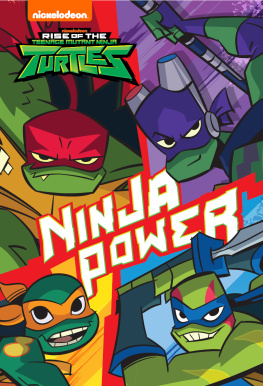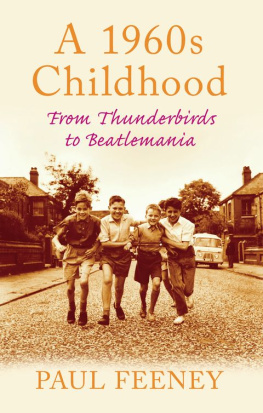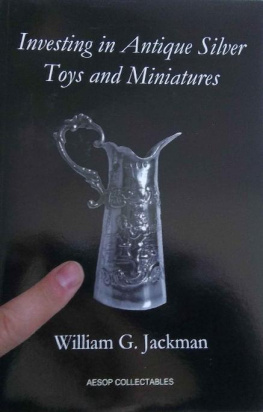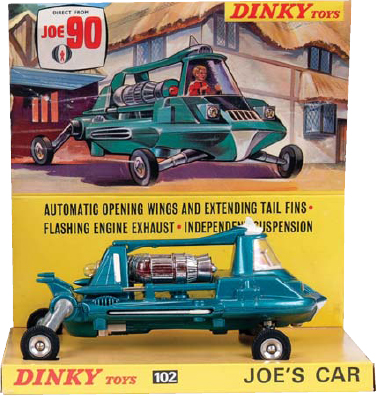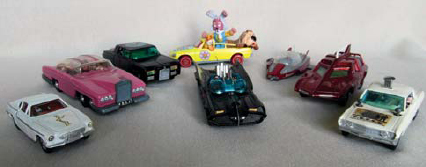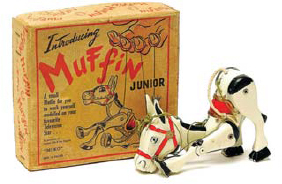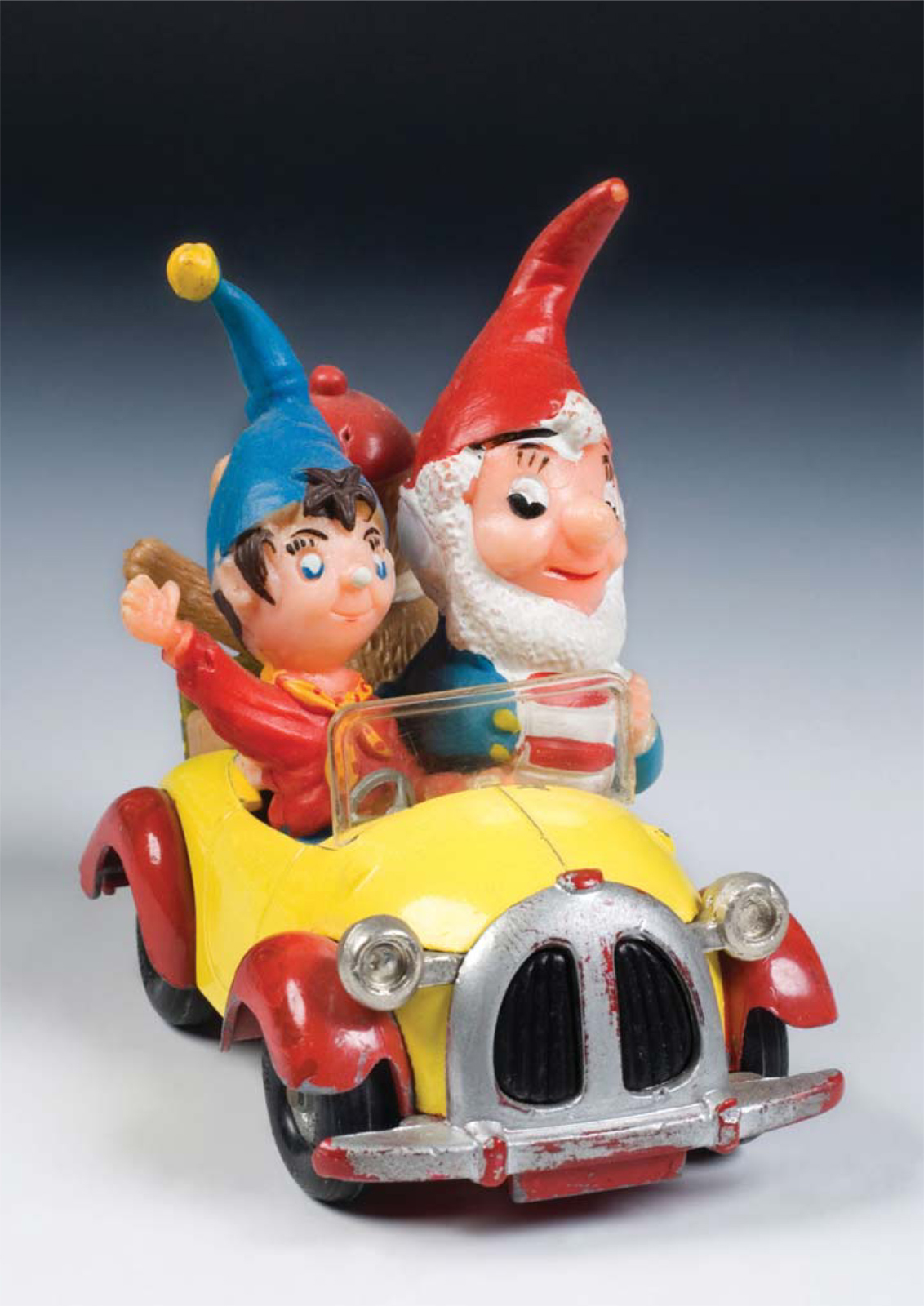TV TOYS
Anthony A. McGoldrick
Dinky diecast model (102) of Joes Car from the Gerry Anderson series Joe 90. The car featured retractable wings and had a battery that lit the rear engine compartment.
SHIRE PUBLICATIONS
Left to right: The Saints Volvo; Lady Penelopes Rolls-Royce; The Green Hornets Black Beauty; Magic Roundabout car and Batmans Batmobile; Supercar; Captain Scarlets Spectrum Patrol Car; The Man From U.N.C.L.E.s Thrush-buster.
CONTENTS
INTRODUCTION
T HIS BOOK is written for the collector of television toys. These days, with over a hundred television channels available twenty-four hours a day, there is plenty of scope for the collector. But in the early days television was much more limited, with a choice of just a few channels, broadcasting for only part of the day.
In the early days of television, toy manufacturing was relatively difficult. There are examples of early bisque dolls with very ornate clothing, or metal prams, or carved wooden rocking horses and soldiers. Tin train sets and lead-based vehicles were around from the turn of the twentieth century, but good examples of these are rare, most often seen in museums. Raw materials were hard to come by and during the two world wars resources such as wood, metal and fabric were used for the war effort, and not for luxuries such as toys. As television grew in popularity, so too did the manufacturing of toys. Thus, the toys from the earlier television programmes are rarer and often more expensive. As toy production progressed through the 1970s and 80s, cheaper materials were used and toys were often produced in vast numbers, with many of them being imported from the Far East. Many of these toys are less well made and consequently do not hold much financial value.
Some collectors may acquire TV toys related to a variety of programmes while others will specialise in one specific series or genre. There are collectors who are devotees of programmes such as Star Trek or Doctor Who and will collect nothing else, while others may have a collection related to cartoons, detective series, sci-fi, police programmes, or anything to do with Gerry Anderson.
An early boxed stringed puppet of Muffin the Mule by Moko.
Although television had its beginnings as far back as 1929, when the first broadcast was made, it did not become popular until well after the end of the Second World War. Strange as it may now seem, in those days few people owned their own house or had a car, and newly married couples would set up home with hand-me-downs from relatives. To own a television set was the height of luxury. Children would play games in the street with a stick or a metal hoop, or would just be expected to use nature as their playground. However, there was some public entertainment; people enjoyed going to the cinema and listening to the radio, and they read comics, books and newspapers. The characters in those media were the forerunners of many of the TV toys, which nowadays have become a multi-million pound global industry.
After the war Britain began to settle back into peacetime life. BBC radio broadcast more entertainment programmes than news bulletins, and people who were fortunate enough to see a television set would catch their first glance of a programme dedicated to children. The programme was called For the Children and was presented by Annette Mills. She played the piano, talked to the children, and was accompanied by a friend called Muffin the Mule, who sat on the piano lid. The character was so popular that Muffin the Mule was given his own show, which ran on television until 1955.
Muffin the Mule became the first accredited toy to be related to a television programme. Pelham Puppets produced a wooden version of Muffin. Another company, Moko (later called Lesney, then Matchbox), produced a diecast figure of Muffin consisting of ten metal parts that were strung together as a puppet. Boxed versions are rare and can command high prices. While this is a relatively expensive toy nowadays, it is also part of a highly specialised collectors market, as are a number of early radio and television collectables. People tend to collect items that they can remember or relate to, and the earliest programmes were made over seventy years ago.
In 1949 The Lone Ranger was released as a television programme. This black-and-white series featured Clayton Moore as the hero, with a Native American, Jay Silverheels, as Tonto. The show ran for several years and was very popular. The tradition of cowboys and Indians as toys had been around for a long time, but for the TV series toys were produced with pictures of the stars on the packaging. Small plastic figures were released by a well-known toy manufacturer, Crescent Toys. These were generally unpainted and very affordable for children. Toy pistols and rifles were manufactured by a company called Lone Star and, while the unboxed versions are still fairly common, it is difficult to find good examples with their original boxes. Perhaps the most identifiable toys relating to the Lone Ranger series were the dolls produced by Louis Marx. They manufactured a range of figures, including the leading characters, various villains, and even the horses. These figures were about 12 inches tall and fully articulated, with many accessories.
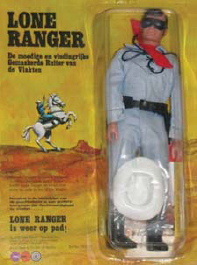
A carded doll of the Lone Ranger by Marx.
Corgi No. 801 Noddy and Big Ears, with Tubby Bear. The car also came with a Golly figure in the back seat.
THE 1950 S
I T WAS IN THE 1950s that television emerged as a popular entertainment. The biggest event of the 1950s for the British was the coronation of Queen Elizabeth II in 1953. The event was televised, and millions of people sought access to a television set in order to experience the celebrations. At that time, the BBC was the only channel broadcasting television in Britain. ITV did not start broadcasting until 1955, and then only on special television sets that could receive what were called Band III programmes. Television was strictly controlled, and programmes were shown only between 9 a.m. and 11 p.m. They were mainly factual, educational and sport; however, several programmes were devised for the entertainment of children.
As early as 1950, when most people were still listening to the radio rather than watching television, a programme called Whirlygig was shown featuring a character called Mr Turnip (see overleaf). Pelham Puppets, who were already producing Muffin the Mule, brought out a wooden stringed puppet of MrTurnip, one of the first toys to be made in relation to a television programme.
Since the end of the war materials such as white metal and lead had again become available for toy making. Also, new tooling and techniques enabled toys to be produced and packaged in bright, attractive boxes some of which are scarcer and so more collectable than the toy themselves, because the packaging was often thrown away while the child kept and played with the toy.

